A reader emailed me in the New Year to point out that it has been months since I last posted a garden update. They weren’t complaining, but they were disappointed that I’d abandoned my regular garden updates last summer.
The truth is, by late summer, I’d basically abandoned the gardens.
Unless you live in a cave, you no doubt know that California’s lack of rainfall over the past 13 months has resulted in a record-breaking, headline stealing, drought.
As we depend on an agricultural well for the farm’s water supply, we’ve been tightening water use on the farm since early last summer. If our well runs dry, which has already happened to some of our neighbors, we have no water. The animals (and humans) on the farm, until this drought period breaks, must have priority on water usage.

Our animals, including the goats, and chickens, are much more important at the moment than our gardens
Although we planted a full-scale vegetable garden last season, by late summer we had already stopped irrigating heat-tolerant plants, including peppers, and eggplants, and as the tomatoes had already set fruit, we ceased irrigating those too.
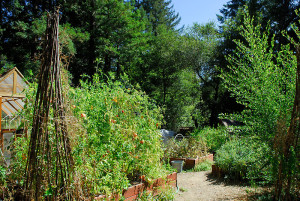
The garden early last September was already past its prime, and we stopped irrigating everything except the orchard
I’d pulled most of the garden by late September, whereas in a normal year we can still be harvesting tomatoes in early November.
We anxiously awaited the fall rains, and in anticipation of their arrival I went ahead and planted kale, peas, and garlic in the late fall garden. However, October passed, then November, December, and by January we’d still had barely two inches of rain in our current rain year. I finally broke down in January, taking pity on the kale plants sitting in bone-dry garden beds, and watered them, twice, all the while keeping my eyes on the long range forecast models.
We did finally receive a little over three inches of rain last weekend though, but it’s still not a cause for celebrating, as we only stand at just over 5 inches of total rainfall in this rain year, not the greater than 30 inches we might expect, so we’re confronting another very dry season ahead.
At the moment we’re still trying to decide whether or not planting a vegetable garden makes sense for us this year. There’s no question that food prices in California will escalate this summer, unless we receive some significant rainfall in the next few weeks, but our dependency on a well for all of our water needs makes it difficult to justify the extra water use on the farm.
For now, I’m starting a few tomato and pepper seeds in trays, and by the time they need to be transplanted, we’ll have a better idea as to our total rainfall this season. Worst case scenario we can simply compost them if the rain doesn’t materialize. The majority of our produce this season though, is likely to come from the Farmer’s Markets.
In the meantime, while in the garden rummaging for seed trays, I discovered we had apparently sown a Skilton’s Skink (Plestiodon skiltonianus skiltonianus) in one of the empty seed trays. This individual is demonstrating its breeding colors, so perhaps at least a few extra skinks will sprout on the farm this year?
It’s not all doom and gloom in the garden at the moment though, and even I was somewhat surprised at the relative amount of green in the garden with the recent rain.
The Russian kale bed looks a little raggedy from the lack of mid-winter water, but perked up quite a bit after last weekend’s storm series.
The Lacinato and dwarf kales are a little smaller than I’d expect this time of year, but are pushing new growth, and if we see a little more rain the plants will no doubt catch up.
The big surprise, once I pulled back the row cover, was the garlic.
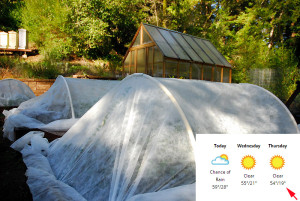
In December the entire garden was covered in row covers in advance of predicted record cold temperatures
Part of the reason I covered the garlic in fall was not to protect it from frost during December’s cold snap, as garlic is actually quite hardy, but to help trap moisture. Last season the crop failed due to a lack of winter rain, but this season, with no supplemental moisture since October, the plants look much healthier. The water tends to condense on the inside of the row cover, and drips back onto the soil, but unlike plastic, it allows the plants to breathe. So, note to self, frost covers are just as useful at preventing excessive moisture loss during a dry winter, as they are at keeping Jack Frost at bay.
I removed the row cover this week though, as the daytime temperatures have been warm since the recent rain, and air circulation is imperative this time of year to prevent rust from forming on the leaves. Hopefully these plants will now make it through to May/June for the bulb harvest.
At the moment it stands that we’ll harvest the winter garden, but the question remains as to whether or not we can justify a summer garden this year.
With the exception of a few perennial crops, like asparagus, vegetable gardens are generally an annual investment. Although our orchard is only a few years old, it is a long-term investment.
Last season we severely restricted water use in the orchard, irrigating just enough to keep the trees alive, but there’s no question these young trees were stressed. However, there are signs of life, as our Aprium ‘Flavor Delight’ has been in bloom since the middle of January! Now, hot on its heels, the rest of the plums and pluots are starting to burst with bloom too.
I expect fruit production to be scant this season though, and we’re considering pulling the fruit from all the trees this year after fruit set, so the trees can conserve energy, and water, this season, but we’ll see what the weather does over the next few weeks.
In other garden news, after the collapse of the Rosemary hive last summer, miraculously, we have succeeded in coaxing all three of our remaining hives through winter, at least so far.
A hive inspection after the loss of Rosemary, however, showed that our Salvia hive was booming!
However, 2 weeks ago, Salvia looked precariously weak, and at one point I thought the hive was already a dead-out. I resisted opening the lid though to avoid chilling the bees, and opted to wait and see. All of our colonies are weak, for this time of year, as nectar has not been nearly as abundant this winter, but since the rain there are some encouraging signs that the hives are starting to build up again.
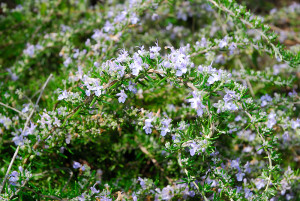
We have a lot of trailing rosemary on the farm, that is now in peak bloom, providing nectar for the bees
As soon as the clouds parted earlier this week, the rosemary plants, which are now blooming up a storm, were abuzz with the girls feverishly foraging for food, and entrance activity, in the sluggish Salvia colony, was definitely picking up, so there is hope for the bees this season. It’s likely to be another difficult year for these girls though, as our bees depend heavily on native forage in this area, so we’ll continue to feed these colonies to help them through what feels like an endless dearth.
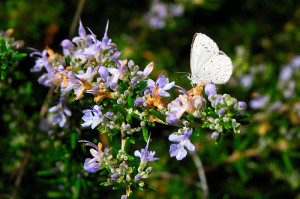
The daytime temperatures have been warm, and we’ve already seen a number of butterflies, and bumble bees too
There’s no question that the stars of our drought-stricken garden at the moment are the native plants. There’s a lot to be said for planting tough, durable, drought resistant, locally adapted plants, as the native garden areas look to be relatively unscathed at the moment. Some, like the sages, haven’t grown much over winter, and others haven’t bloomed much either, including our Manzanitas, but they’re holding their own.
My favorite Ceanothus ‘Puget Blues’ are starting to burst with color, and appear relatively unfazed by the lack of rain.
And even though the native deer grasses are past their prime for the season, they still provide plenty of winter garden interest, especially after we installed some garden lighting to highlight their architectural structure after dark.
The only problem is, now I don’t want to prune them!
One last winter garden bonus this season, is that after waiting three years for this volunteer Ribes sp. shrub to bloom, to identify it, despite record drought, and no supplemental irrigation, bloom it finally did!
It appears to be a malvaceum or sanguineum type, with pink flowers, and a pretty reminder that spring really is just around the corner.
Overall, the winter garden does hold some promise, but with reservoirs around the State still at critically low levels, and water tables continuing to plummet, it’s difficult to know how the gardens will do this year, so cross your fingers that this year we see a lot more spring showers, or this may be the first, and last garden update of the year.
In the meantime, I can’t believe that we’re now just two weeks away from kidding season!
Baby goats are on the horizon, and nothing says spring like baby goats, so stay tuned!

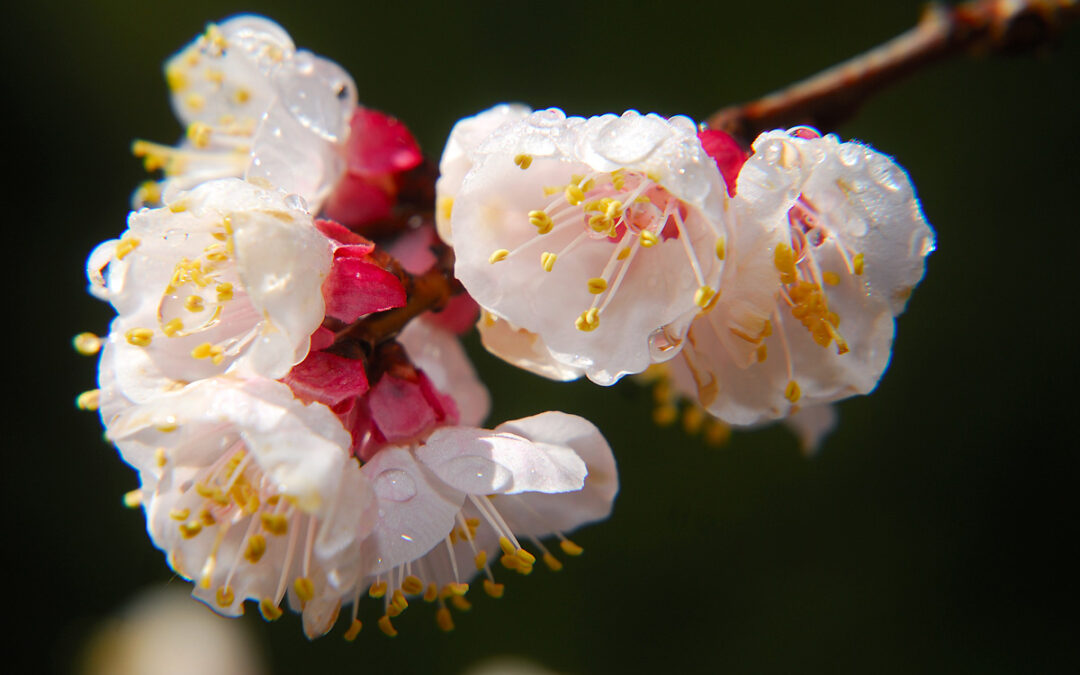
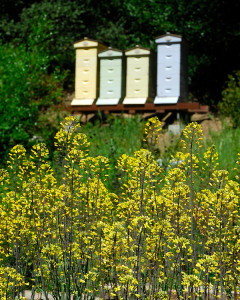

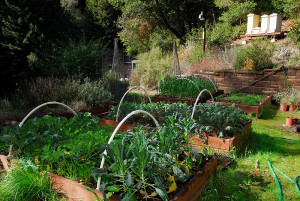
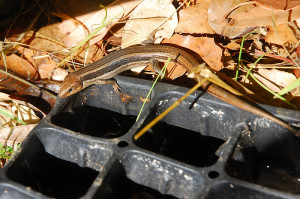
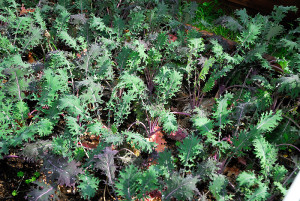


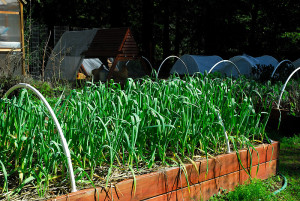
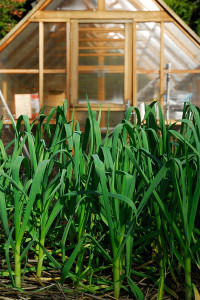
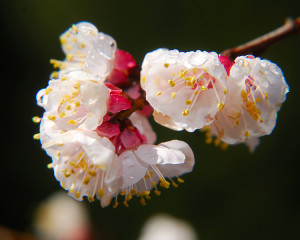

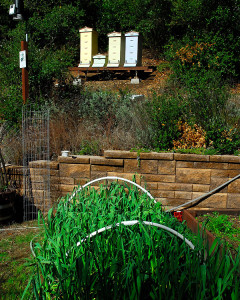
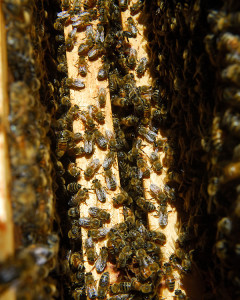
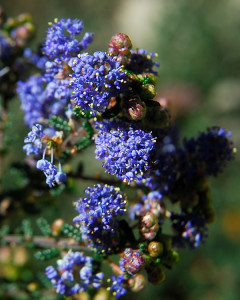
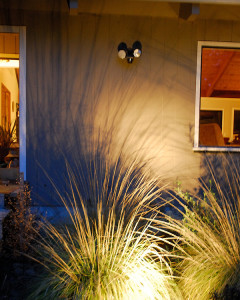

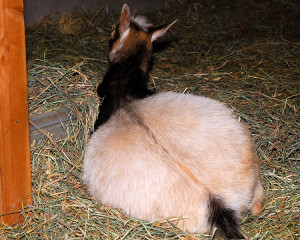







It’s a trial to be sure. Our well is still doing well – neighbors say it’s never run dry. But weather’s never been this dry either. Regarding your volunteer ribes – I recently did a post on keying out my volunteer ribes and you may be able to glean a few key identifiers to see if it’s R. malvaceum or R. sanguineum. I’m betting on malvaceum myself – let me know!
I love keying out things. I do it a lot with fungi, as so many little brown mushrooms look like every other LBM! I agree with you, I’m pretty darned certain my mystery volunteer Ribes is malvaceum. I thought that when I first looked at it, as it is a little different from my sanguineum. I’ve had the same issue with R. sanguineum here, it’s not ever really happy here. The blooms are scant, it never really has thrived. My volunteer though, growing on the north side of the house, is tough as nails. Shame is growing through the step on the deck though…I hate to cut it down, but will probably wait until I can take some cuttings first!
How did your salsify experiment turn out?
We had some in a bed with a carrots, but the voles completely ran amok in that bed, so we ended up clearing the whole thing out. Maybe one advantage of allowing the vegetable garden to go fallow for a season will be that the voles will have to go elsewhere to eat! 😉 We’ll try again, though, once the rains return, but will probably plant it in an area on its own, away from things that voles love to eat!
Thank you for the tip on covering garlic with row cover. I’m glad to know it keeps moisture in.
You may know of the landscape architect Bobby Markowitz in Santa Cruz, who is an expert in water catchment systems. I attended a workshop he led a couple of years ago where we set up a small system to catch rainfall off a livestock shed roof to store in a tank to water horses. It was a huge tank, maybe 5000 gallons. At my house I have 5 55-gallon rainbarrels. That amount is insignificant and proved to be way too expensive for the return even though we cobbled it together with used food-grade barrels, but even 250+ gallons to have on hand is nice for a dire emergency. It’s amazing how much rainfall can come off a roof. Here is a link to water catchment guru Brad Lancaster’s runoff calculator. Although he is located in Arizona, the calculator works for any location. http://www.harvestingrainwater.com/rainwater-harvesting-inforesources/rainwater-harvesting-online-calculator/
We’ve considered a water catchment system here, but we have the same issue that we’d have with a grey-water system, in that the areas we need to get water too are uphill of the areas we’d best be able to recover water from. It would take a very large volume of water, necessitating large tanks, and then an inordinate expense to install the pumps, and pipes, necessary to get the water to where it needs to go. If our terrain wasn’t as highly variable, I do think it would be feasible to install something to at least offset our water use. It is something we’re considering, along with solar power, after we move the farm to a more suitable location though.
I saw a lot of water recovery systems when I was in South America some years ago, and in some areas its the only way some have enough water to last them through the year. Most of the tanks were concrete, enormous, and underground, so as not to take up valuable space above grade. That’s certainly more difficult to do in a retrofit situation. It’s something that is definitely underutilized here in the US though. That said, first it needs to actually rain enough to fill the holding tanks.
So much has happened in your garden…successes more than failures…and the bees and goats are doing well….more goats on the way…can’t wait to see them.
Won’t be long now, and sleep will be a distant memory…with baby goats bouncing around 24/7!
Good luck with the kidding season! I think your garden looks great (especially the Garlic), but I know how frustrating and scary a drought can be. I do hope you get an increase in rain for your acquifers and your crops!
I was genuinely surprised that anything was still green. The only difference this year, over last, is that we covered everything. We only did that because of the threat of record-breaking cold in December, but it seemed to help all the crops by leaving them covered. It’s certainly too warm now, during the day. I’m really crossing my fingers that March will bring some more much needed rain, as we’re still so far behind ‘normal’!
I didn’t realize the drought affected your garden last summer. I know how scary a drought can be, and the possibility of a well running dry. I hope the rains start to make a regular appearance. Your garlic looks great, though, and I’m amazed how well your kale has performed. The spotlighting of the grasses is just gorgeous. Fabulous idea!
So far, the rain in February has mostly been a dud, except for that one storm. Forecast now is dry through the end of the month. That leaves us hinging our hopes on March, as after that point, rain is typically quite scant. There’s no question that 2014 is going to be a challenging year across much of the state!
and then I read that California is exporting alfalfa to China?!
It’s true, Diana. I read the BBC article yesterday too: http://www.bbc.co.uk/news/magazine-26124989
It takes an absurd amount of water out of the Colorado River, and drives prices up here at home. We pay $20-25 PER BALE at the moment, and the quality is awful. Here in California farmer’s are selling are livestock because they have no forage, and farms can’t afford to buy hay to feed their animals in the meantime due the pricing here at home, but we practically give it away to China? That whole situation seriously chaps my hide!